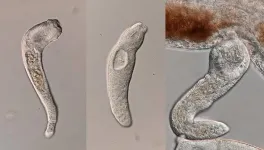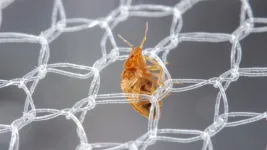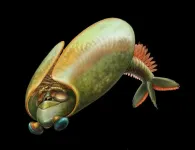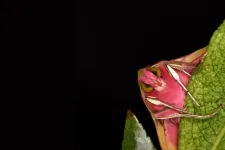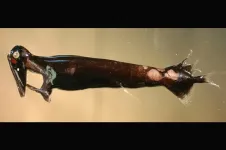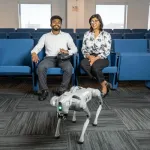(Press-News.org) Research shows humans often perceive attractive people as more intelligent, healthier, better leaders and more trustworthy. It turns out this bias extends to the insect world.
A new study by scientists at the USC Dornsife College of Letters, Arts and Sciences reveals that data reported on a popular community science platform is biased. On iNaturalist, butterflies with captivating markings, easily identifiable features or those that are familiar species are reported more frequently than obscure species with no distinct qualities.
Why it matters: Online community science — or participatory science — platforms enable nature-loving non-scientists to contribute data that scientists use to track insect populations.
While their sightings contribute to conservation decisions, scientific knowledge and education, community scientists can introduce misleading biases, according to the USC Dornsife study.
Understanding and accounting for these biases is key for scientists to estimate species distributions, assess conservation priorities and identify population trends.
The study provides insights for enhancing participatory science programs and butterfly conservation.
USC Dornsife’s Laura Melissa Guzman studies butterflies and other pollinators. (Photo: Olga Burymska.)
In her words: “Each year, 3 million people share their observations of insect life on community-science platforms. This data can help us track declines in butterfly populations, resulting from factors like climate change or pesticide use, but only if it’s accurate,” said Laura Melissa Guzman, Gabilan Assistant Professor of Biological Sciences and Quantitative and Computational Biology at USC Dornsife.
Community science platforms: eButterfly and iNaturalist are the two most popular platforms community scientists use to report butterfly data. Their methods for collecting data differ, though.
On iNaturalist, community scientists are encouraged to share photos of butterfly sightings so experts can verify the species. Information uploaded without a photo, or with an unclear image, cannot be verified.
As a result, difficult-to-photograph butterflies are less likely to be included in the dataset.
On eButterfly, participants can report sightings via a simple checklist that asks when, where, how and what kind of butterfly species was observed.
This method results in a more comprehensive account of all species observed, similar to those data-gathering techniques used in ecological surveys. However, it requires participants to accurately identify the species they report, which can be challenging for beginners.
What they found: The researchers discovered that the iNaturalist method of relying on photos to identify and verify species creates a personal bias toward easily photographed or interesting species.
Users of the iNaturalist platform overreported species with captivating, aesthetically distinctive features like wing tails, checkered patterns, spots, eyespots and stripes.
They underreported many species, particularly those that were difficult to identify and those with light-colored markings on their wings.
Behavioral traits, such as butterflies’ flight style and height, and traits that make butterflies difficult to photograph, may have affected reporting patterns, the researchers surmise.
By the numbers: Overall, 34 species were often underreported and 53 were frequently overreported on iNaturalist compared to eButterfly.
The researchers found that butterflies from the two largest families —Nymphalidae, which includes monarchs (easy to identify and very photogenic) and Lycaenidae (commonly known as gossamer-winged butterflies for their delicate aspect)— were often overreported on iNaturalist.
The most underreported species belonged to the Pieridae family, which are among the most common and aesthetically unappealing, and frequently regarded as garden pests.
Researchers observed similar trends in species reporting among users in the east and west, indicating similar biases among users.
How they did it: In collaboration with North Carolina State researcher Benjamin Goldstein, Guzman and her team compared data shared on iNaturalist and eButterfly from 2000–2021.
Using computational modeling they examined data related to 194 species from five butterfly families in North America, focusing on six factors: prevalence, ease of identification, body size, color diversity, wingspan and wing features, and migratory status.
Next steps: Guzman says improving participatory science requires training observers to identify species and raise awareness of biases that result in the underreporting of species. She recommends two major improvements to community science apps.
Use species-specific reporting methods to reduce users’ biases that can influence ecological studies.
Highlight both popular and underreported species to improve accuracy in the data collection process. END
When it comes to butterflies, people prefer pretty ones. That’s a problem for scientists.
Scientists studying biodiversity rely on public data, but USC Dornsife researchers found that butterfly sightings on one popular online platform are skewed by personal preferences.
2024-07-24
ELSE PRESS RELEASES FROM THIS DATE:
UBC Okanagan study raises concerns about partner violence in queer relationships
2024-07-24
When people think of a concussion or a traumatic brain injury caused by intimate partner violence (IPV), they might picture people in a heterosexual relationship, or a man hurting a woman.
But a UBC Okanagan researcher points out that IPV, and its repercussions, is an issue in all relationships. Doctoral student Tori Stranges recently published a paper examining the prevalence and damage done by violence in Two-Spirit, Lesbian, Gay, Bisexual, Trans, Queer (or Questioning), Intersex and Asexual (2SLGBTQIA+) relationships.
“It’s very common for people to think that violence doesn’t ...
Human-infecting parasite produces sterile soldiers like ants and termites
2024-07-24
New research from scientists at UC San Diego’s Scripps Institution of Oceanography finds a tiny freshwater parasite known to cause health problems in humans defends its colonies with a class of soldiers that cannot reproduce.
The discovery, published today in the Proceedings of the National Academy of Sciences and funded by the National Institutes of Health, vaults this species of parasitic flatworm into the ranks of complex animal societies such as ants, bees and termites, which also have distinct classes of workers and soldiers that have given up reproduction to serve their colony.
When it gets into humans, usually via the consumption of raw or undercooked fish, this species ...
The unintended consequences of success against malaria
2024-07-24
For decades, insecticide-treated bed nets and indoor insecticide spraying regimens have been important – and widely successful – treatments against mosquitoes that transmit malaria, a dangerous global disease. Yet these treatments also – for a time – suppressed undesirable household insects like bed bugs, cockroaches and flies.
Now, a new North Carolina State University study reviewing the academic literature on indoor pest control shows that as the household insects developed resistance ...
Taco-shaped arthropod from Royal Ontario Museum’s Burgess Shale fossils gives new insights into the history of the first mandibulates
2024-07-24
A new study, led by palaeontologists at the Royal Ontario Museum (ROM) is helping resolve the evolution and ecology of Odaraia, a taco-shaped marine animal that lived during the Cambrian period. Fossils collected by ROM reveal Odaraia had mandibles. Palaeontologists are finally able to place it as belonging to the mandibulates, ending its long enigmatic classification among the arthropods since it was first discovered in the Burgess Shale over 100 years ago and revealing more about early evolution and diversification. The study The Cambrian Odaraia alata and the colonization of nektonic suspension-feeding niches by early mandibulates was published ...
Butterflies accumulate enough static electricity to attract pollen without contact, new research finds
2024-07-24
Butterflies and moths collect so much static electricity whilst in flight, that pollen grains from flowers can be pulled by static electricity across air gaps of several millimetres or centimetres.
The finding, published today in the Journal of the Royal Society Interface, suggests that this likely increases their efficiency and effectiveness as pollinators.
The University of Bristol team also observed that the amount of static electricity carried by butterflies and moths varies between different species, and that these variations correlate with differences in their ecology, such as whether they visit flowers, are ...
Eyes for Love: Searching for light and a mate in the deep, dark sea, male dragonfishes grow larger eyes than the females they seek
2024-07-24
Chestnut Hill, Mass (07/24/2024) – A small but ferocious predator, the male dragonfish will apparently do anything for love. Or at least to find a mate.
A new study by researchers at Boston College found the eyes of the male dragonfish grow larger for mate-seeking purposes, making the dragonfish an anomaly in vertebrate evolution, the team reported today in the Royal Society journal Biology Letters.
Like many creatures that inhabit the dark depths of the sea, dragonfishes survive thanks to numerous ...
PNNL scientists tap nation’s fastest computers to explore critical science questions
2024-07-24
RICHLAND, Wash.—Researchers at the Department of Energy’s Pacific Northwest National Laboratory have been awarded more than 3 million node hours on the nation’s most powerful computers to explore questions around pathogens, climate and energy-efficient microelectronics.
Access to the nation’s supercomputers, granted to Margaret Cheung, Daniel Mejia Rodriguez and Po-Lun Ma, is a coveted prize among scientists. The node hours represent an investment of several million dollars in computing time awarded to PNNL scientists to explore important science questions.
The awards are among 44 projects awarded through ...
Peri-operative care of transgender and gender-diverse individuals: new guidance for clinicians and departments published
2024-07-24
New guidance on peri-operative care of transgender and gender-diverse individuals is today published in Anaesthesia (the journal of the Association of Anaesthetists) to guide best practice to ensure the safety and dignity of transgender and gender-diverse people in the peri-operative period. The guidance has been produced by a working group of experts including Dr Stuart Edwardson, Royal Infirmary of Edinburgh, Edinburgh, UK, and Dr Luke Flower, Victor Philip Dahdaleh Heart and Lung Research Institute, Cambridge, UK, and colleagues.
The number of people openly identifying ...
Clinical psychologist’s book addresses largely ignored problem: social anxiety
2024-07-23
RIVERISDE, Calif. -- We all have some social anxiety. The nervousness we might feel before giving a speech is one example. Some people, however, have more social anxiety than others, and limit their social engagement due to excessive chronic fears of being embarrassed or humiliated. Although such social anxiety is common in both adolescents and adults, it is rarely diagnosed and treated.
In a new book titled “Social Anxiety: Hidden Fears and Shame in Teens and Adults,” Thomas E. Brown, a clinical professor of psychiatry and neuroscience in the University of California, Riverside's School of Medicine , explains ...
Researchers leveraging AI to train (robotic) dogs to respond to their masters
2024-07-23
An international collaboration seeks to innovate the future of how a mechanical man’s best friend interacts with its owner, using a combination of AI and edge computing called edge intelligence.
The project is sponsored through a one-year seed grant from the Institute for Future Technologies (IFT), a partnership between New Jersey Institute of Technology (NJIT) and Ben-Gurion University of the Negev (BGU).
Assistant Professor Kasthuri Jayarajah in NJIT’s Ying Wu College of Computing is researching how to design a socially assistive model ...
LAST 30 PRESS RELEASES:
Urban wild bees act as “microbial sensors” of city health.
New study finds where you live affects recovery after a hip fracture
Forecasting the impact of fully automated vehicle adoption on US road traffic injuries
Alcohol-related hospitalizations from 2016 to 2022
Semaglutide and hospitalizations in patients with obesity and established cardiovascular disease
Researchers ‘listen in’ to embryo-mother interactions during implantation using a culture system replicating the womb lining
How changing your diet could help save the world
How to make AI truly scalable and reliable for real-time traffic assignment?
Beyond fragmented markets: A new framework for efficient and stable ride-pooling
Can shape priors make road perception more reliable for autonomous driving?
AI tracks nearly 100 years of aging research, revealing key trends and gaps
Innovative techniques enable Italy’s first imaging of individual trapped atoms
KIER successfully develops Korea-made “calibration thermoelectric module” for measuring thermoelectric device performance
Diversifying US Midwest farming for stability and resilience
Emphasizing immigrants’ deservingness shifts attitudes
Japanese eels, climate change, and river temperature
Pusan National University researchers discover faster, smarter heat treatment for lightweight magnesium metals
China’s 2024 Gastroenterology Report: marked progress in endoscopy quality and disease management
Pusan National University researchers uncover scalable method for ultrahigh-resolution quantum dot displays
Researchers use robotics to find potential new antibiotic among hundreds of metal complexes
Gut bacteria changes at the earliest stages of inflammatory bowel disease
Scientists develop new way to “listen in” on the brain’s hidden language
Brain research: “Pulse generators” grow and shrink as memories are formed
For teens, any cannabis use may have impact on emotional health, academic performance
School meals could unlock major gains for human and planetary health
Menopause hormone therapy does not appear to impact dementia risk
Signature patterns of brain activity may help predict recovery from traumatic brain injury
Dresden study uncovers new key mechanism in cancer cells
New species are now being discovered faster than ever before, study suggests
Cannabis-based products show limited short-term benefit for chronic pain, with increased risk of adverse effects
[Press-News.org] When it comes to butterflies, people prefer pretty ones. That’s a problem for scientists.Scientists studying biodiversity rely on public data, but USC Dornsife researchers found that butterfly sightings on one popular online platform are skewed by personal preferences.
